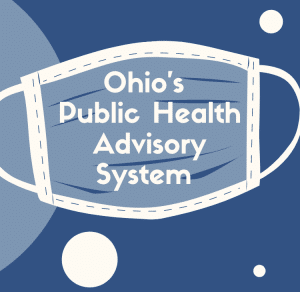
On July 8, Ohio Department of Health Interim Director Lance D. Himes ordered the implementation of the Public Health Advisory System (PHAS) to supplement statewide orders, inform Ohioans about their risk of contracting the virus, and to combat COVID -19. The PHAS is a color-coded system that is used to assess the degree of COVID-19 spread and to help in the local and state virus response. The system creates four alert levels, each applied at the county level. Each alert level is attributed to a level of risk and is calculated using data from seven key indicators. Each alert level carries strong recommendations and guidelines for communities to combat the virus such as travelling only when necessary when a county is at level four. In counties with an alert level of three or four, citizens are mandated to wear facial coverings in public unless certain exceptions apply like being under 10 years old. Once a county reaches level three or higher, the facial covering mandate goes into effect that day for that county and stays in effect until the county is at an alert level two or lower, the governor’s state of emergency no longer exists, or the health director rescinds or modifies the order.
The PHAS currently uses seven key indicators with three others under development to be included in the system. Each indicator is grouped under one of five data categories which assess how many cases there are in a county, how many people seek medical care for their COVID-19 or COVID-19-like symptoms, hospital resource capacity, if there is untraced community spread, and community testing levels. In the order issued by Interim Director Himes, ODH is also using qualitative data to augment the data and provide a more holistic view of each county’s situation which impacts the alert level. Examples of qualitative data include a county’s proximity to a high-risk community and local efforts to mitigate the virus.
The three key indicators used to determine the case level in each county are new cases per capita, sustained increases of new cases, and the proportion of cases not in congregate settings. New cases per capita must be 50 new cases per 100,000 residents over the previous two weeks for this indicator to be triggered. Calculating cases per capita also allows for the comparison between counties, regardless of their individual population sizes. A sustained increase in new cases indicates that a virus is spreading more in that county and that there is a risk of community spread. If there is a five-day period of sustained growth in new cases, the indicator is triggered. The proportion of cases not in congregate settings also indicates risk for community spread as those who are not in nursing homes or prisons are likely to come into contact with others. This indicator is triggered when in one week in the last three weeks at least 50% of new cases were not in a congregate setting.
The number of people seeking care in emergency departments (ED) or in outpatient settings for COVID-19 or COVID-19-like symptoms show how many people are sick enough to seek care and are early warning signs of virus activity. The key indicator regarding ED visits measures the trend of people with COVID-19 symptoms and who are not diagnosed with another respiratory illness. The indicator is triggered when there is a five-day period of increase in COVID-19 related visits. The key indicator regarding outpatient visits is similar in that this indicator is triggered if there is an increase in confirmed COVID-19 or COVID-19 suspected diagnoses after seeing a doctor over a five-day period.
Hospitals only have so much capacity to deal with an influx of new patients without resorting to crisis levels of care. The key indicators that show the burden on hospitals and their resources are a sustained increase of new COVID-19 patient admissions and intensive care unit (ICU) bed occupancy. A sustained increase in new COVID-19 or COVID-19-like hospital admissions over a five-day period triggers this indicator. In the calculation, the patients’ county of residence is considered, not the county of hospitalization. ICU bed occupancy is a key indicator because it shows the resource burden on hospitals for long-term treatment of COVID-19 patients and because of this, it considers both COVID-19 and non-COVID-19 use of ICU beds. This indicator is triggered when 80% of ICU beds are utilized in the county.
Of the 10 key indicators included in the health order, three are still under development. Once measure details and data sources are established, the PHAS will soon use tests per capita, percent positivity, and the rate of new cases from contacts of known cases in the alert level calculation. In the order, it is suggested that 150 tests per 100,000 people per day will be the baseline for the tests per capita indicator and that it would be triggered if testing were at a lower rate. Additionally, a high percentage of tests that come back positive would trigger the percent positivity indicator as it would show that there are likely many undetected cases and a need for more testing resources. Finally, the contact tracing indicator would assist in understanding what portion of cases are coming from known transmission chains versus cases that come from untraced community spread.
County alert levels are updated every Thursday and are calculated based on the data from the key indicators. Once the indicators for testing and contact tracing become available and COVID-19 conditions change, counties may shift to higher alert levels. Recommendations for residents living in counties at an alert level of three or four include limiting attending gatherings of any number, decreasing interaction with others, and limiting travel to only what is necessary. This new guidance based on a county’s risk level will help Ohioans understand the measures they can take to combat the virus.
